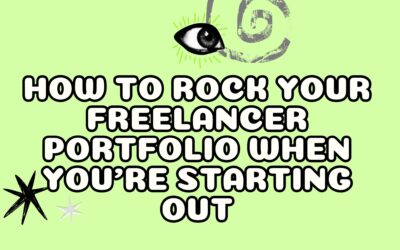I’m not the biggest fan of LinkedIn.
I’ve never been a fan of it and recently it seemed to get more… salesy?
My inbox was full of people trying to sell me something and the posts on my homepage all seemed to be lightly veiled humble brags.
But I’d heard from a lot of freelancers that LinkedIn was THE place to be. And, with the threat of Twitter going up in flames, I was keen to try out some other platforms. I’ve always managed to get a fair few leads from LinkedIn–we’re probably talking one a month here.
I’ve had my profile optimised for a while and I have quite a few good connections in the industry, so it’s never been difficult per se to attract clients there.
So I wanted to see how far I could really push the platform.
The Plan
I decided I’d post every day for a week. I knew I wouldn’t have the capacity to keep this cadence up, but I wanted to see what would happen if I did post every day.
The next thing I had to think about was: What the heck was I going to post???
LinkedIn isn’t like Twitter.
I couldn’t post witty one-liners or anything that bashed my clients in any way on LinkedIn (not that there’s much to bash, there’s just a few funny anecdotes that I’m far more inclined to share on Twitter where I have a bigger audience of fellow freelancers).
So what would I post?
How I decided what to post on LinkedIn
1. Decided what I wanted to achieve with LinkedIn
I spent some time looking through other posts on LinkedIn and deciding where I wanted to position myself.
I knew that I didn’t want to be a humble bragster.
I also knew that I didn’t want to spread my personal life out for everyone to see.
Here’s what I figured out when I sat down and really thought about it:
- I wanted to be an authority on content in the customer experience
- I wanted to share parts of my process that clients love
- I wanted to write about content strategy and all the things I’ve learned over the past 8 years
- I wanted to post candid, honest, and “human” stuff
2. Brainstormed post ideas based on my goals
Off the back of this, I brainstormed some topics that fit into these bullet points. It looked a bit like this:
- Content strategy
- Idea generation
- Freelancer/client relationships
This gave me a framework to generate ideas from (which I’ve compiled in my handy LinkedIn prompts for freelancers downloadable – you can get it here if you haven’t already!). Within each category, I dug deeper and jotted down everything I could think of to do with each topic.
For example, in the idea generation category, I noted down:
- Tools I use to generate ideas
- Unusual ways I generate ideas
- Examples of how other people generate ideas
It gave me a ton of ideas because I could also drill down further into each of THOSE topics.
For example, for the “unusual ways I generate ideas” concept, I could create a post that walks through each way I generate content ideas. That’s probably about seven or so posts straight off the bat.
When you start to dig deeper and deeper, there are actually SO MANY things you can write about. But it helped me to have an organised selection of possible posts that fit into my overall goals with LinkedIn: to become an authority on content in the customer experience
3. Bulk-created posts in advance
Instead of scrambling to write a fresh post every day, I bulk-created my posts for the week. I already had tons of ideas and prompts so I just sat down one morning for a couple of hours and drafted out a series of posts.
Some were really long (but remember LinkedIn has a character limit of 3,000!) and some were shorter, but because I’d done my initial research, I knew they would all tie back to my overall vision and help me reach my goals.
If, like me, you struggle to schedule time for your own brand stuff and find yourself scrambling every so often when you “haven’t posted in aaaaaages”, I highly recommend bulk-creating your LinkedIn posts. You can thank me later 😉
The posts I created for LinkedIn
1. How SaaS brands can improve their homepage copy
2. A controversial opinion
3. A tip for better freelancer-client relationships
4. A key mistake brands make with content
5. How brands can make their content stand out
6. How to add storytelling to content
7. Different types of posts brands can create
See my full LinkedIn profile here for more!
My LinkedIn experiment: How it all played out
Here’s what went down.
Caveat here: your mileage may vary. I started out with about 1,350 connections on LinkedIn and was getting an average of 100+ profile views each week without doing anything, so I wasn’t starting totally from scratch.
Here’s what I did:
- Spent 10 mins engaging with content on the #saas and #contentmarketing hashtags each day
- Published one post about content marketing/SaaS content every day for seven days
In total, the posts generated 7,500 impressions (and counting), 90 reactions, and 31 comments, and I got about 60 new followers.
Perhaps most importantly, I had 3 new leads reach out to me.
The content I posted was aimed at SaaS brands and their content marketing efforts, and I posted at the same time every day (about 9am UK time). I’m not sure if it would have made any difference posting at a different time.
Measuring Success Beyond the Numbers
When experimenting with LinkedIn (or any platform), it’s easy to focus on metrics like impressions, comments, and leads. But there’s more to success than what’s immediately measurable. Beyond the numbers, I noticed a few key benefits that weren’t as tangible—but were just as valuable:
Clarity on my niche.
Posting daily forced me to articulate my expertise in a way that resonated with my audience. Over the week, I gained a clearer understanding of how to position myself as an authority in content strategy for customer experience.
Confidence in my voice.
There’s something about consistently showing up that builds confidence. By the end of the week, I felt more at ease sharing my insights and engaging with others on LinkedIn.
Connections and conversations.
While leads are the ultimate goal, the relationships I built with other freelancers and brands were equally valuable. Several thoughtful conversations in the comments section helped me expand my network and opened up potential collaborations down the line.
The takeaway? Don’t limit your definition of success to the metrics LinkedIn shows you. Sometimes, the real value lies in how the process sharpens your brand, boosts your confidence, and connects you with like-minded professionals. These are long-term wins that can compound over time.
My tips for freelancers using LinkedIn to get leads
I can now totally see what other freelancers mean when they say LinkedIn is the place to be. Unlike Twitter, you have more space to cite your expertise and grow your authority on a topic. Which is crucial for freelancing success – when I niched down and became an expert on a topic, I doubled my income and found more clients were coming to me.
But what do I think made my LinkedIn experiment work well?
What I think worked and my tips:
- Write content for your target audience: what are their pain points and what can you help them with?
- Provide quick wins: the content I put out was very practical with tips and walkthroughs so my followers learned something actionable with every post
- Include hashtags: I included about 4 relevant hashtags with each post—ones that focused on my audience (#SaaS) and ones that focused on the content of my posts (#contentmarketing)
- Engage with others: I’m not sure how LinkedIn’s algorithm works, but adding insightful comments to others posts also shows up in your followers’ feeds
The most important thing to note is that none of the leads who reached out reacted or commented on my posts (although two of them did mention they enjoyed the posts).
Moral of the story?
You never know who’s watching!
I got to engage with some great brands and freelancers, create some visibility around my services and expertise, AND generate a few leads in the process.
Not bad for about 20 minutes work a day for a week!
Would you try this? Have you already tried something like this? What’s your LinkedIn strategy?
If you need help figuring out what to post on LinkedIn, I gotcha! Get my list of prompts for freelancers right here 😘






0 Comments